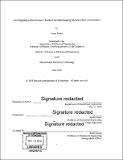Investigating a non-invasive method for determining muscle fiber composition
Author(s)
Treers, Laura
DownloadFull printable version (4.672Mb)
Other Contributors
Massachusetts Institute of Technology. Department of Mechanical Engineering.
Advisor
Anette Hosoi.
Terms of use
Metadata
Show full item recordAbstract
This study aims to explore a new method for analysis of muscle fiber type, using data collected from weightlifts on a leg press. A dynamic muscle model is developed, which utilizes the Descherevskii kinetic theory in combination with a muscle "matrix" model to predict net muscle contraction forces and velocities as a function of fiber type. These relationships are integrated into a dynamic model for lifting a weight, allowing for the derivation of joint trajectories in time, from the molecular properties of muscle. The model-predicted velocity trajectories for the lift are compared with curves obtained experimentally from weightlifting trials. Longer lifts with slower peak velocities indicate higher ratios of slow-twitch fibers, and shorter lifts with greater peak velocities indicate higher ratios of fast-twitch fibers. This idea is supported by both the model results and in experimental trends. With further refinement of experimental protocols, the leg press test has the potential to be a powerful training tool for athletes-both to compare their muscle makeup with other athletes, and to track their own progress over the course of their training.
Description
Thesis: S.B., Massachusetts Institute of Technology, Department of Mechanical Engineering, 2018. Cataloged from PDF version of thesis. Includes bibliographical references (pages 39-40).
Date issued
2018Department
Massachusetts Institute of Technology. Department of Mechanical EngineeringPublisher
Massachusetts Institute of Technology
Keywords
Mechanical Engineering.